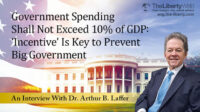Featuring Dr. Arthur Laffer, Father of Supply-Side Economics [Part 8]
Problems of Keynesian Economics, a COVID-19 Trend (Part 1)
Fiscal policies based on the Keynesian economic theory, as a theory of economic recovery, are underway in developed countries. If Keynesian theory is used to further implement unemployment measures, government debt will keep rising. Dr. Laffer spoke on the problems surrounding Keynesian economics.
Interviewer: Hanako Cho
Cho: Developed countries are implementing Keynesian policies under the current pandemic and increasing government spending. Please explain once again the problems of Keynesian economics.
Dr. Laffer: There’s a very different view of the world between the Keynesians and myself.
Keynesian economics basically starts out that people work because there are jobs. They believe that what the government needs to do is create aggregate demand, so there are jobs.
Now I don’t believe that people work because there are jobs. I believe that people work to get paid after tax. It’s that very personal and very private incentive that motivates people to work or not work.
Keynesians believe that people save because their incomes are high, and their savings depend on their income. I believe that people save in order to make an after-tax rate of return on their investments.
Keynesians also believe that if the government is short of money and running a deficit, all it needs to do is raise taxes. They believe that doing so will automatically reduce the deficit because they’ll collect more money.
I don’t always believe that’s true. Sometimes if you raise taxes, you reduce the incentive for people to work, save and invest, so you will collect less revenues.
Economics is all about incentives. When you change incentives, people change their behavior. To a Keynesian, that’s not true; to a Keynesian, incentives are not what drives people. They don’t look at their after-tax wages nor after-tax rate of return. They don’t look at how high taxes are. Keynesians think that people are going to work as much anyway.
Growthist vs. Redistributionist
Dr. Laffer: Now the two groups that have been battling from the beginning of time have been, what I like to consider myself, a growthist, and the other group of Keynesians are redistributionists. It’s a very different view of the world.
Keynesians want equality of income and stimulus spending, so they want to increase government spending. To me, the key to being human, the key to society, is the idea of growth, progress and prosperity over long periods of time.
Natural State of the Economy Differs Greatly
Dr. Laffer: Let me describe to you the way Keynesians think.
The mathematics is that people save as a matter of their income. They say that if people save too much, incomes will drop and there will be unemployment. The natural state of the economy for Keynesians is underemployment, under-consumption and an economy driven by too little demand. Therefore, the supply is not there; workers get no jobs. With no jobs, they don’t spend their money. With no spending of money, there are even more job losses.
Keynesians believe that a capitalistic society will not function well under this natural state of the economy. They believe that the government has to augment government spending in order to be able to absorb those excess savings so the economy can remain at full employment.
You hear your government talk about creating jobs all the time. You hear them say, ‘We need to have government spending to stimulate the economy.’
My view is exactly the opposite of that view, and it’s that to stimulate the economy, you need to remove government as an impediment for people to earn more income. Therefore, the natural state of the economy (note: a natural state in which the government as an impediment is removed) is full employment. Government taxes and spending cause the very problem they’re trying to cure.
‘Government Spending Creates Jobs’
Dr. Laffer: Now let me give you the logic underpinning the Keynesian view of government spending.
If I give someone $600, don’t you think that person will spend more than they otherwise would have spent?
Cho: Of course.
Dr. Laffer: They will use that money to buy more things, and that in turn will create jobs and increase productivity. There will be this cascading multiplier effect from the initial $600 which will create all of these jobs down the line. In economics, the multiplier effect describes how government spending for investment triggers a ripple effect. Keynesians believe that it will lift the economy up by the bootstraps.
I want to be a little technical with you here. The increase in output from the government spending is the $600 times the multiplier, which is equal to one over one minus the marginal propensity to consume (MPC). The MPC describes the percentage of the initial $600 that the recipient buys goods with. Let’s say that the recipient of the $600 check spends 60% of it on consumption and keeps the other 40% as their savings. In this case, the MPC is 0.6. Since the multiplier is one over one minus the MPC, the multiplier here will be 2.5:
Multiplier=1/(1-MPC)=1/(1-0.6)=2.5
The multiplier is 2.5, so if investment spending increases by 10, GDP increases by 25. GDP increases by 2.5 times the investment spending. According to this logic, if the multiplier is 2.5 and government spending increases by $600, GDP will increase by $1,500.
When you hear people talk about stimulus spending, they say that we can increase the demand in the economy by the multiplier times the stimulus spending and create prosperity.
This is their economics. It does make sense. If I gave you more money, wouldn’t you go out and have a sake or sushi?
‘There is No Stimulus in Stimulus Spending’
Dr. Laffer: That’s one chapter of a three-chapter book. Let me talk about the second chapter of the book.
Unfortunately, the government doesn’t create resources. The government redistributes resources. If I give you $600, I have to take that $600 from someone else. There’s no such thing as a free lunch.
It is very true that if I gave you $600, you would spend more. And that will create jobs. But what happens to the people from whom I take the $600?
They would spend less than they otherwise would have spent. If they spend less, they’ll create less jobs. There will be less spending on the part of them, and that will cascade in the exact opposite direction with the exact same multiplier. So, while the people you give the money to spend more, the people you take the money from will spend less. If you take $600 from one group and give it to the other group, the total effect on the economy is zero.
This is known as the Slutsky equation, in which a change in the economy is decomposed into an income effect and a substitution effect. The income effect breaks down the effect caused by a change in real income. When you add the Slutsky equation of a whole economy, you find that income effects of government spending or taxation always equal zero. Always. The stimulus to the transfer recipient is offset by the de-stimulus to the transfer payer.
There is no net stimulus whatsoever.
Let’s imagine we have an economy and the price of apples rise.
When the price of apples rises, apple growers have higher incomes. They’ll be richer, which means they’ll spend more.
But what about apple consumers? If the price of apples rises, apple consumers will have lower incomes and be poorer. They will spend less.
These two effects, the stimulus and the de-stimulus, offset each other to the 9,000th decimal place, by the second, by the minute, by the week, by the month, by the year. There is no stimulus in stimulus spending. You stimulate the people you give the money to, but you de-stimulate the people from whom you take the money. Keynesians always talk about the recipients of government spending. They never talk about the payers of government spending.
Cho: Does this mean that Keynesians intentionally ignore the effect of stimulus spending on transfer payers?
Dr. Laffer: They don’t think about it. Every one of them.
The story I’m telling you is exactly the way the Keynesians describe stimulus spending. ‘Government spending stimulates the economy, and it has a multiplier because people spend part of the stimulus money. That creates more jobs, and there is this whole multiplier effect that stimulates the economy.’ Chapter one is correct. But chapter two is that people from whom the money is taken will spend less, and they’ll de-stimulate the economy by the exact same amount as the economy was stimulated by the spending of government money to the transfer recipients. Next, I’ll talk about the third chapter that Keynesians ignore.
![Featuring Dr. Arthur Laffer, Father of Supply-Side Economics [Part 8]](https://eng.the-liberty.com/wp-content/themes/lw/images/logo.svg)
![Featuring Dr. Arthur Laffer, Father of Supply-Side Economics [Part 8] Featuring Dr. Arthur Laffer, Father of Supply-Side Economics [Part 8]](/files/2021/01/8184_l.jpg)

















